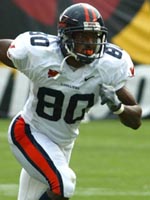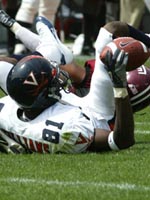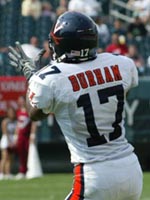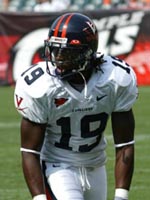2003 Review
 Michael McGrew |
The Virginia receiving corps took an early blow last year when its lone returning starter, Michael McGrew, suffered a broken leg during training camp. McGrew is back for 2004 but his skills were clearly missed a year ago. The losses in experience are even greater this season.
With the return of Marques Hagans to the quarterback position, the graduation of Ryan Sawyer and Art Thomas, and the loss of Ottowa Anderson and Shannon Lane in the summer, the Cavaliers did not return any of their top four wide receivers from 2003.
Last season, however, did produce the emergence of Fontel Mines and Deyon Williams as viable candidates to replace Sawyer, Anderson and company. Emmanuel Byers redshirted but showed promise in training camp and in 2004 spring drills.
The loss of Thomas takes away a game-breaking type of player but also an inconsistent one. Saywer was a solid receiver but not spectacular. He may be missed more as a run blocker and as an exceptional special-teams performer. McGrew’s return should compensate for the loss of Sawyer.
The speedy Williams saw extensive action as a true freshman, finishing the regular season with eight receptions for 122 yards. Williams also ran the ball twice for 23 yards. Mines, who is often compared to former UVa standout Billy McMullen, made his debut against Western Michigan, scoring an 18-yard touchdown on his first catch. On the year, Mines caught six passes for 66 yards.
2004 Depth Chart
Y-Wide Receivers
Deyon Williams (6-3 188 So.)
Career Starts: 1 – Career Games: 11
Imhotep Durham (5-11 168 Jr.)
Career Starts: 0 – Career Games: 1
Z-Receivers
Michael McGrew (6-2 201 Sr.)
Career Starts: 24 – Career Games: 35
Inj – Fontel Mines (6-4 222 So.)
Career Starts: 1 – Career Games: 12
X-Wide Receivers
Emmanuel Byers (5-5 191 Fr.)
Career Starts: 1 – Career Games: 0
Ron Morton (6-1 185 So.)
Career Starts: 0 – Career Games: 2
Michael McGrew was Virginia’s second-leading wide receiver in 2002 with 27 receptions for 428 yards and two touchdowns. For his career, McGrew has played in 35 games, tallying 64 catches for 802 yards and four touchdowns.
McGrew is a big-play threat who the ‘Hoos missed in 2003. Starting opposite Billy McMullen two years ago, he led the team with a 15.9 yards-per-catch average. Against Wake, Duke, Georgia Tech and Maryland, McGrew had at least one reception covering 34 yards or more, all of which put Virginia in the red zone.

|
Deyon Williams is still developing all aspects of his game, including how to utilize his speed to get separation from defensive backs. Coach Groh believes that Williams can significantly improve his game when he learns to use his speed advantage. Williams seldom misses a catchable throw.
Like Williams, Fontel Mines is a work in progress, though his progress will be temporarily halted by a broken collarbone suffered last Saturday at Temple. Once he returns and learns to use his 6-4, 222-pound body to seal off defenders, he could be special.
“Every receiver’s about creating space, some how, some way,” Groh said. “Some guys do it with vertical speed. Some guys do it because they’re shiftier. Some guys do it with size, but [Mines] is going to be more of a size receiver. When he learns how to use his size, then he’s going to be able to create space.”
Fans often forget that catching passes is just a part of the wideout’s role in the Virginia offense. “There’s so much more that goes into it,” Groh said. “Over the course of 55, 60, 65, 70 plays, it shows up. Whether it’s converting routes, knowing whom to block on the force or the depths of routes.”
Both Mines and Williams made significant strides in camp to be more complete wide receivers.
 Imhotep Durham |
Walk-on Imhotep Durham was a pleasant surprise during training camp. He never even played high school football but brings good speed, hands and leaping ability to the unit. He recently received a scholarship after joining the team as a walk-on three years ago.
Coaches hope they have uncovered an “X” factor, literally, in Emmanuel Byers , who plays the “X” slot and could help with UVa’s vertical passing game. The speedy freshman will be expected to contribute immediately after redshirting in 2003. He was impressive in fall camp and made his first reception as a Wahoo against Temple. Byers has turned heads in practice at the slot position vacated by Hagans. At some point down the road, he may make people say “Biscuit Who?” He may have the best set of hands on the team and the redshirt year has helped him develop both size and technique. He seems to do well from motion in getting separation from the defender but still needs work from a stationary standpoint. That said, Byers is definitely a potential impact player.
Ron Morton is showing flashes but then again he always has shown flashes. Virginia fans have been looking for the speedy sophomore to emerge as that “stretch the field” receiver the Cavaliers have needed. He did not make the trip to Philadelphia but is likely to receive playing time in Mines’ absence.
All-ACC Candidate
Michael McGrew
All-American Candidate
None
2004 Analysis
 Emmanuel Byers |
What immediately strikes observers about the Virginia receiving corps is its diversity. There is speed and size, big-play and possession guys who can be deployed in various sets and formations.
One priority for the Virginia offense in 2004 is getting more production from the wideouts. Last season 40 percent of UVa’s receptions and 46 percent of the passing yards went to running backs and tight ends. Now when you have players like Alvin Pearman, Wali Lundy and that Miller guy out there catching passes, it makes sense to throw the ball to those players. But by adding that additional dimension to the offense – a group of productive receivers who can stretch the field and eat up significant chunks of yardage – it makes the team that much harder to defend.
With the return of McGrew and the experience gained by Mines and Williams, Virginia should get more production from the wide receiver position. Hopefully Morton and Byers will make an impact and stretch the field. If so, both would add needed depth and viable long threats to the offense.
Both Mines and Williams improved their strength during the off-season, so look for both to be threats to break free for good yards after catch (YAC) and be better blockers on the force.
This is a quality (but very young) group of receivers. If they can become more physical, catch everything in range, block on the perimeter and play with consistency, Virginia will be able to do some damage with this group in 2004.



